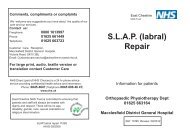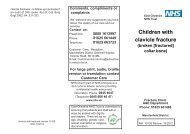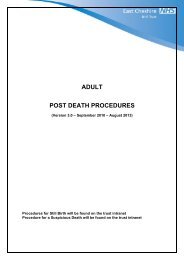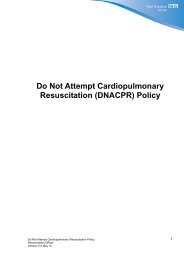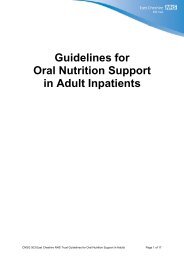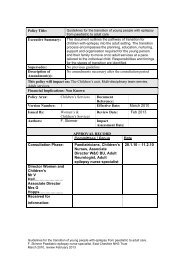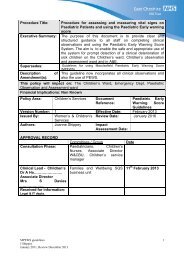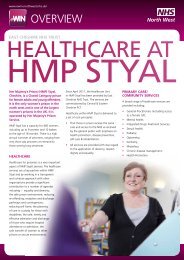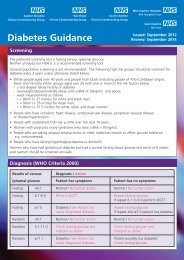Peripartum Collapse and Amniotic Fluid Embolism - East Cheshire ...
Peripartum Collapse and Amniotic Fluid Embolism - East Cheshire ...
Peripartum Collapse and Amniotic Fluid Embolism - East Cheshire ...
Create successful ePaper yourself
Turn your PDF publications into a flip-book with our unique Google optimized e-Paper software.
<strong>Peripartum</strong> <strong>Collapse</strong> <strong>and</strong> <strong>Amniotic</strong><strong>Fluid</strong> <strong>Embolism</strong><strong>Peripartum</strong> <strong>Collapse</strong> <strong>and</strong> <strong>Amniotic</strong> <strong>Fluid</strong> <strong>Embolism</strong> 1May 2013 Review May 2016 Version 3.0E Alston RM SoM (updated)
Policy Title:<strong>Peripartum</strong> <strong>Collapse</strong> <strong>and</strong> <strong>Amniotic</strong> <strong>Fluid</strong> <strong>Embolism</strong>Executive Summary: To aid early identification of a problem so that appropriate<strong>and</strong> evidenced based management can be implemented.This will then improve the outcome for mother <strong>and</strong> baby inwhat can be a rare but potentially fatal event e.g. Cardiacarrest in 1:30,000 deliveries, amniotic fluid embolus in 17 in100 000 deliveries.Supersedes: Previous guideline Version 2.0Description ofAmendment(s):Evidence from the RCOG Green Top Guideline Number 522011Trust format & Equality analysis toolInvolvement of Consultant Obstetrician <strong>and</strong> Anaesthetist<strong>and</strong> HaematologistThis policy will impact on: Families <strong>and</strong> Wellbeing Business UnitFinancial Implications: Non KnownPolicy Area: Families <strong>and</strong>Wellbeing BusinessUnitDocumentReference:<strong>Peripartum</strong><strong>Collapse</strong> <strong>and</strong><strong>Amniotic</strong> <strong>Fluid</strong><strong>Embolism</strong>Version Number: 3.0 Effective Date: May 2013Issued By: Maternity Service Review Date: May 2016Author:Michelle Moran RM ImpactMay 2013SoMUpdated by E AlstonRM SoMAssessment DateAPPROVAL RECORDConsultation Phase:Obstetric Clinical leadMr RDeverarj………………….DateCommittees / GroupLabour Ward Forum, MSLC.Obstetricians Midwives, GPRepresentative, Link TutorLead Anaesthetist,Resuscitation Officer, BloodTransfusion practitioner,Consultant HaematologistMaternity <strong>and</strong> Women’sService Clinical GovernanceCommitteeDateMay 2013May 2013Head of MidwiferyMrs LMoorcroft………………DateReceived for information IT Dept & Legal Services May 2013<strong>Peripartum</strong> <strong>Collapse</strong> <strong>and</strong> <strong>Amniotic</strong> <strong>Fluid</strong> <strong>Embolism</strong> 2May 2013 Review May 2016 Version 3.0E Alston RM SoM (updated)
Content1.0 Policy Statement1.1 Background1.2 Organisational Responsibilities1.3 Planning <strong>and</strong> Implementation2.0 Measuring Performance <strong>and</strong> Audit2.1 Review2.2 Definition2.3 Incidence of <strong>Amniotic</strong> <strong>Fluid</strong> <strong>Embolism</strong> (AFE)2.4 Pathophysiology3.0 Clinical presentation3.1 Communication3.2 Acute Management4.0 Fetal Assessment consider peri-mortem Caesarean Section4.1 Long term Management4.2 Documentation4.3 Debriefing4.4 National Register5.0 Audit /monitoring compliance of this guideline6.0 References:7.0 Equality Anlaysis Tool<strong>Peripartum</strong> <strong>Collapse</strong> <strong>and</strong> <strong>Amniotic</strong> <strong>Fluid</strong> <strong>Embolism</strong> 3May 2013 Review May 2016 Version 3.0E Alston RM SoM (updated)
1.0 Policy StatementMaternal collapse is a rare but life-threatening event with a wide-ranging aetiology.The outcome, primarily for the mother but also for the fetus, depends on prompt <strong>and</strong>effective resuscitation. This guideline supports the practitioner in the recognition <strong>and</strong>care of a woman with a peripartum collapse <strong>and</strong> amniotic fluid embolism1.1 BackgroundTo aid early identification of a problem so that appropriate <strong>and</strong> evidenced basedmanagement can be implemented. This will then improve the outcome for mother<strong>and</strong> baby in what can be a rare but potentially fatal event. The guidance takes intoconsideration the requirement from the National Health Service Litigation AuthoritySt<strong>and</strong>ard 1 Criterion 6 – Labour ward Staffing1.2 Organisational ResponsibilitiesChief ExecutiveHas ultimate responsibility for the implementation <strong>and</strong> monitoring of the policies inuse in the Trust. This responsibility may be delegated to an appropriate colleague.Clinical Leads/Head of MidwiferyWhere Clinical Leads/Head of Midwifery are asked to ratify this guideline they areresponsible for the review of the guideline <strong>and</strong> the final ratification prior to theguideline actually being implemented. This ratification process will take placefollowing the consultation <strong>and</strong> approval process.Trust CommitteesAs a group are responsible for the consultation <strong>and</strong> approval process required duringthe development of guidelines for the Trust. The committees are responsible for thereview of guidelines submitted to them to ensure that guidelines are appropriate,workable <strong>and</strong> follow the principles of best practice.All StaffIt is incumbent on relevant staff, when asked, to provide comments <strong>and</strong> feedback onthe content <strong>and</strong> practicality of guidelines that are being developed <strong>and</strong> reviewed. It isthe duty of all staff when asked, to provide assistance during the development <strong>and</strong>review stages of guideline formulation.StakeholdersAre those people with an interest in a guideline who contribute, comment <strong>and</strong> agreeto the content of the guideline. They include specific committees, groups or forums,individual colleagues, whole departments, service users <strong>and</strong> their families.1.3 Planning <strong>and</strong> ImplementationThis guideline supports the practitioner in the recognition <strong>and</strong> care of a woman with aperipartum collapse <strong>and</strong> amniotic fluid embolism<strong>Peripartum</strong> <strong>Collapse</strong> <strong>and</strong> <strong>Amniotic</strong> <strong>Fluid</strong> <strong>Embolism</strong> 4May 2013 Review May 2016 Version 3.0E Alston RM SoM (updated)
Newly ratified guidelines are included on the maternity newsletter. Relevant staffhave the responsibility to ensure awareness of the contents of the guideline <strong>and</strong> toinform their Line Manager of any training needs which may affect their ability to followthis guideline2.0 Measuring Performance <strong>and</strong> AuditThe Trust will measure performance of this guideline as indicated underAudit/Monitoring Compliance below.2.1 ReviewThis guideline will be reviewed every three years or sooner following findings fromaudit, changes to national guidance, or in response to clinical practice. Theresponsibility for the review of guidelines lies with the Practice DevelopmentMidwives who will report to the overarching Maternity <strong>and</strong> Women’s Service ClinicalGovernance Committee.2.2 DefinitionMaternal collapse is defined as an acute event involving the cardiorespiratorysystems <strong>and</strong>/or brain, resulting in a reduced or absent conscious level (<strong>and</strong>potentially death), at any stage in pregnancy <strong>and</strong> up to six weeks after delivery.2.3 Incidence of <strong>Amniotic</strong> <strong>Fluid</strong> <strong>Embolism</strong> (AFE) 17 direct deaths per 100 000 deliveries a mortality rate of 0.80 per 100 000deliveries. The classical scenario of amniotic fluid embolism usually involves an older,multiparous woman in advanced labour who suddenly collapses, develops DIC<strong>and</strong> dies rapidly thereafter2.4 Pathophysiology <strong>Amniotic</strong> fluid can enter maternal circulation through endocervical veins <strong>and</strong>frequently does so without detrimental effect. In others it causes inflammatory response with rapid collapse similar toanaphylaxis or septic shock. The volume of fluid entering the maternal circulation does not seem relevant.Two main pathological effects are:1 Haemodynamic collapse2 CoagulopathyThe haemodynamic collapse appears Biphasic with vasospasm <strong>and</strong> pulmonaryhypertension in the first phase. 15-30mins later the second phase begins with leftventricular failure, coronary artery vasospasm <strong>and</strong> myocardial ischemia.No single obstetric intervention was identified as a risk factor in the last triennialreport but maternal age over 25yrs does increase the risk (only one woman under25 in the last 2 reports)<strong>Peripartum</strong> <strong>Collapse</strong> <strong>and</strong> <strong>Amniotic</strong> <strong>Fluid</strong> <strong>Embolism</strong> 5May 2013 Review May 2016 Version 3.0E Alston RM SoM (updated)
3.0 Clinical presentation Clinical picture does not depend on finding fetal squames or debris in thepulmonary circulation. Usually in labour but can be ante <strong>and</strong> postnatal. Sudden dyspnoea with cardiovascular collapse within minutes. 10-20% present with seizures 40% will follow with coagulopathy 10-15% will present with coagulopathyIn many cases, women who suffer an amniotic fluid embolism report some or all ofthe following:premonitory symptoms:Breathlessnesschest painfeeling coldlight headednessrestlessnessdistresspanic, a feeling of pins <strong>and</strong> needles in the fingersnausea <strong>and</strong> vomiting.3.1 CommunicationSummon emergency help by phoning 2222 <strong>and</strong> ask for the1. Obstetric team2. Neonatal team should be called early if delivery is likely3. Cardiac Arrest Team if a cardiac arrest is suspectedThe consultant obstetrician <strong>and</strong> consultant obstetric anaesthetist should besummonedEnsure the senior midwife on duty attendsThe transfusion laboratory should be contacted as soon as possible to requestblood <strong>and</strong> blood products as appropriate (ext 1808 between 08:00 <strong>and</strong> 20:00 <strong>and</strong>at other times on mobile phone short code 4450).Consultant Haematologist canbe contacted via switchboard for adviceIn the community setting, basic life support should be administered <strong>and</strong> rapidtransfer arranged, unless appropriate personnel <strong>and</strong> equipment are available.3.2 Acute ManagementThe management of AFE is supportive rather than specific, as there is no proveneffective therapy.Maternal resuscitation should follow the Resuscitation Council (UK) guidelines usingthe st<strong>and</strong>ard A, B,C approach with some modification for a pregnant woman.A = airwayB = breathingC = circulation<strong>Peripartum</strong> <strong>Collapse</strong> <strong>and</strong> <strong>Amniotic</strong> <strong>Fluid</strong> <strong>Embolism</strong> 6May 2013 Review May 2016 Version 3.0E Alston RM SoM (updated)
Airway clear <strong>and</strong> maintained by:Aggressive treatment of early collapse with early recourse to intubation,The airway should be protected as soon as possible by intubation with a cuffedendotracheal tubeSupplemental oxygen should be administered as soon as possible.Bag <strong>and</strong> mask ventilation should be undertaken until intubation can be achieved.Breathing assess by:Look, listen <strong>and</strong> feel for normal breathing for no more than 10 secondsIgnore any occasional gasps patient may make.If in doubt treat as though the patient is not breathing.Supplemental oxygen should be administered as soon as possible.Bag <strong>and</strong> mask ventilation should be undertaken until intubation can be achievedEnsure help has been summoned even if you have to leave the patient to phone2222 yourself.CirculationCheck for signs of life, if none present:Start chest compressions, place heel of h<strong>and</strong> in centre of chest one h<strong>and</strong> on topof the other interlocking fingers. Perform 30 chest compressions at a rate of 100-120 beats per min to a depth of 5-6 cm followed by 2 ventilationsA left lateral tilt of 150 on a firm surface will relieve aortocaval compression in themajority of pregnant women <strong>and</strong> still allow effective chest compressions to beperformed.The same defibrillation energy levels should be used as in the non-pregnantpatient.Continue until resuscitation team arriveResuscitation efforts should be continued until a decision is taken by theconsultant obstetrician, <strong>and</strong> consultant anaesthetist in consensus with the cardiacarrest team.Two wide-bore cannulae should be inserted as soon as possible.Take blood for full blood count, X match 2 units blood as a minimum Preload toheart should be optimised with rapid infusion of fluidsOn top of resuscitation <strong>and</strong> supportive measures, arrhythmias may develop <strong>and</strong>will require st<strong>and</strong>ard treatment. Inotropic support is likely to be needed <strong>and</strong>measurement of cardiac output may help direct therapy <strong>and</strong> avoid fluid overload,as this will exacerbate pulmonary oedema <strong>and</strong> increases the risk of acuterespiratory distress syndromeCoagulopathy needs early, aggressive treatment, Plasma substitutes <strong>and</strong>treatment must start before results are available <strong>and</strong> until specific fluids areapplied i.e. Fresh Frozen Plasma, O negative blood, platelets, cryoprecipitateOngoing care will require invasive central monitoringConsider the use of anti coagulant therapyThe incidence of uterine atony is increased in AFE <strong>and</strong> may contribute to apostpartum haemorrhage. Refer to the <strong>East</strong> <strong>Cheshire</strong> NHS Trust PostpartumHaemorrhage <strong>and</strong> massive haemorrhage guidelinesAttention to fluid balance <strong>and</strong> prevention of multi-organ failure e.g. ARDS, renalfailure, sepsis, neurological h<strong>and</strong>icap is requiredSupport <strong>and</strong> care of partner <strong>and</strong> family should not be forgotten<strong>Peripartum</strong> <strong>Collapse</strong> <strong>and</strong> <strong>Amniotic</strong> <strong>Fluid</strong> <strong>Embolism</strong> 7May 2013 Review May 2016 Version 3.0E Alston RM SoM (updated)
4.0 Fetal Assessment consider peri-mortem Caesarean Section If gestation ≥ to 26 weeks watch the time - fetal survival better if delivered within 5minutes of maternal death, therefore decision needed at 4 min Perimortem caesarean section should not be delayed by moving the woman – itshould be performed where resuscitation is taking place. The operator should use the incision that will facilitate the most rapid access. Fetal survival < 15% after 15min. For many of the causes of maternal collapse early delivery improves the maternalresuscitation. Therefore normal care re haemostasis, antibiotics <strong>and</strong> avoidanceof other maternal injury must be considered4.1 Long term ManagementMulti-organ failure Will need multi-disciplinary care on ITU if mother survives. ARDS, renal, neurological, sepsis all of particular concern. Take blood ASAP for FBC, U/E, LFT'S, RBS, Ca, Mg. Urates, Coagulationincluding D Dimer, X Match minimum 2 units Other investigations will depend on clinical picture e.g. XRAY, CT, Blood Gases Refer to the <strong>East</strong> <strong>Cheshire</strong> NHS Trust High Dependency Care guideline4.2 Documentation Accurate documentation in all cases of maternal collapse, whether or notresuscitation is successful, is essential. Where possible ensure a scribe isallocated to document time <strong>and</strong> events. Scribe records must be filed in thematernal records All cases of maternal collapse should generate a clinical incident form <strong>and</strong> thecare should be reviewed through the clinical governance process. Complete a SBAR (Situation, background, assessment, recommendation) formfor all maternal transfers4.3 DebriefingDebriefing is recommended for the woman, her family <strong>and</strong> the staff involved inthe event.4.4 National RegisterAll cases of suspected or proven amniotic fluid embolism, whether fatal or not, shouldbe reported through the monthly card notification system to:The United Kingdom Obstetric Surveillance System (UKOSS)The National Perinatal Epidemiology UnitUniversity of OxfordOld Road CampusOld RoadHeadingtonOxford, OX3 7LF<strong>Peripartum</strong> <strong>Collapse</strong> <strong>and</strong> <strong>Amniotic</strong> <strong>Fluid</strong> <strong>Embolism</strong> 8May 2013 Review May 2016 Version 3.0E Alston RM SoM (updated)
5.0 Audit /monitoring compliance of this guidelineThis Guideline will be audited in line with the Key Performance Indicators identified inthe NHS Litigation Authority CNST Maternity St<strong>and</strong>ards 2012/13 - St<strong>and</strong>ard 1Criterion 6Minimum Requirements Method of Assessment CNST St<strong>and</strong>ardLabour Ward Staffing A minimum of 1% or 10 1.6sets, whichever is theRequirement for agreater of all healthconsultant obstetricianrecords of women whoattendance in personhave delivered in allcare settingsCoordination of auditAny audits undertaken will be the responsibility of the Practice DevelopmentMidwivesReporting arrangementsThe Practice Development Midwives will report the results of audit to the overarchingMaternity <strong>and</strong> Women’s Service Clinical Governance Committee Any action plans willbe tabled at the overarching Maternity <strong>and</strong> Women’s Service Clinical GovernanceCommittee by the Practice Development MidwivesActing on recommendationsThe audit recommendations <strong>and</strong> subsequent action plan will be discussed <strong>and</strong>agreed by the overarching Maternity <strong>and</strong> Women’s Service Clinical GovernanceCommittee.The Maternity <strong>and</strong> Women’s Service Clinical Governance Committee will agreewhich individual will be responsible for action(s) within a specified timeframe. This willbe documented on the action plan <strong>and</strong> within the minutes from the Maternity <strong>and</strong>Women’s Service Clinical Governance Committee.Changes in practice <strong>and</strong> lessons to be sharedAny required system or organisational change to practice will be discussed <strong>and</strong>agreed by the overarching Maternity <strong>and</strong> Women’s Service Clinical GovernanceCommittee. Changes to practice will be identified <strong>and</strong> actioned within a specified timeframe. A lead member of the team will be identified to take each change forward.This will be documented on the agreed action plan <strong>and</strong> monitored at the Maternity<strong>and</strong> Women’s Service Clinical Governance Committee on a monthly basis untilcompletion.Lessons will be shared with the relevant stakeholders<strong>Peripartum</strong> <strong>Collapse</strong> <strong>and</strong> <strong>Amniotic</strong> <strong>Fluid</strong> <strong>Embolism</strong> 9May 2013 Review May 2016 Version 3.0E Alston RM SoM (updated)
These guidelines cannot anticipate all possible circumstances <strong>and</strong> exist onlyto provide general guidance on clinical management to cliniciansThis guideline has been assessed using the Equality Analysis Screening Tool6.0 References:Advance Life Support Sub- Committee (1998) ‘Advanced Life Support Manual( 5e)’Resuscitation Council , London.Clark S. (1997) ‘<strong>Amniotic</strong> fluid embolism:current concepts’. Contemp Rev ObstetGynaecol. 9(4): 297-301<strong>East</strong> <strong>Cheshire</strong> NHS Trust Ante partum Haemorrhage<strong>East</strong> <strong>Cheshire</strong> NHS Trust Postpartum Haemorrhage Guideline<strong>East</strong> <strong>Cheshire</strong> NHS Trust Massive Haemorrhage GuidelineLewis G (ed) 2007. ‘The Confidential Enquiry into Maternal <strong>and</strong> Child Health(CEMACH) Saving Mothers’ Lives: reviewing maternal deaths to make motherhoodsafer 2003-2005. The Seventh Report on Confidential Enquiries into MaternalDeaths in the United Kingdom.’ London. CEMACH.National Health Service Litigation Authority Clinical Negligence Scheme for Trust(CNST) Maternity St<strong>and</strong>ards 2012/2013RCOG Green-top Guideline No. 56 2011. Maternal <strong>Collapse</strong> in Pregnancy <strong>and</strong> thePuerperiuma20112011ternal <strong>Collapse</strong> in Pregnancy <strong>and</strong> theResuscitation Council (UK). Resuscitation Guidelines 2012[http://www.resus.org.uk/pages/guide.htm].Yerby. M. ‘Maternal <strong>and</strong> neonatal resuscitation.’ In: "Sundle H (ed) EmergenciesAround Childbirth .Radcliffe Medical Press Ltd, Oxon ISBN-1 85775 568 5Yerby M. ‘<strong>Amniotic</strong> <strong>Fluid</strong> <strong>Embolism</strong>’. In Sundle H. (ed) Emergencies AroundChildbirth. Radcliffe Medical Press Ltd Oxon ISBN-1 85775 568 5<strong>Peripartum</strong> <strong>Collapse</strong> <strong>and</strong> <strong>Amniotic</strong> <strong>Fluid</strong> <strong>Embolism</strong> 10May 2013 Review May 2016 Version 3.0E Alston RM SoM (updated)
7.0 Appendix 1.0Equality Analysis (Impact assessment)1. What is being assessed?<strong>Peripartum</strong> <strong>Collapse</strong> <strong>and</strong> <strong>Amniotic</strong> <strong>Fluid</strong> <strong>Embolism</strong>Details of person responsible for completing the assessment: Name:E Alston Position: Registered Midwife Team/service: Maternity ServicesState main purpose or aim of the policy, procedure, proposal, strategy or service:(usually the first paragraph of what you are writing. Also include details of legislation,guidance, regulations etc which have shaped or informed the document)Maternal collapse is a rare but life-threatening event with a wide-ranging aetiology. The outcome, primarilyfor the mother but also for the fetus, depends on prompt <strong>and</strong> effective resuscitation. This guidelinesupports the practitioner in the recognition <strong>and</strong> care of a woman with a peripartum collapse <strong>and</strong> amnioticfluid embolism2. Consideration of Data <strong>and</strong> ResearchTo carry out the equality analysis you will need to consider information about the people whouse the service <strong>and</strong> the staff that provide it.2.1 Give details of RELEVANT information available that gives you an underst<strong>and</strong>ingof who will be affected by this documentThe population of <strong>Cheshire</strong> as at the 2005 mid year figures (Cohesia Report 2008) is684,400.Age:17.8% (30,500) of the population in <strong>Cheshire</strong> <strong>East</strong> is over 65 compared with 15.9%nationally. This results in a high “old age” dependency ratio, i.e. low numbers ofworking-age people supporting a high non-working dependant older population. Thepercentage of “older” or “frail” old is also considerably higher, with 2.3% (8,200)persons 85 <strong>and</strong> over compared to 2.1% nationally.<strong>Cheshire</strong> <strong>East</strong> has the fastest growing older population in the North West. By 2016,the population aged 65+ will increase by 29.0% (8,845) <strong>and</strong> the population aged 85+by 41.5% (3,403).This will have an impact on the number of patients being managed by ECT <strong>and</strong> thecomplexity of the health <strong>and</strong> social care issues that the older person is experiencing.In addition the staffing profile of ECT will change to include an increasing number ofstaff over 65 in the workforce.<strong>Peripartum</strong> <strong>Collapse</strong> <strong>and</strong> <strong>Amniotic</strong> <strong>Fluid</strong> <strong>Embolism</strong> 11May 2013 Review May 2016 Version 3.0E Alston RM SoM (updated)
Race:The 2005 mid year estimate (Cohesia Report 2008) show that the majority of thepopulation in <strong>Cheshire</strong>(94.6%) is White British, with 5.4% non White British. The <strong>Cheshire</strong> 2007-10 LocalArea Agreementidentified that minority ethnic communities account for around 3% of the population.Issues for BME communities include lack of knowledge of services, access toservices, access to translation/interpretation, cultural differences, family values.Many people from BME communities experience poverty, poor housing <strong>and</strong>unemployment which make it difficult for them to lead healthier lives. 4180 migrantworkers registered in <strong>Cheshire</strong> in 2006/07 <strong>and</strong> comparison to the mid-year population estimates for <strong>Cheshire</strong> in 2005 strongly suggests that <strong>Cheshire</strong>’smigrant worker population is larger than every individual BME group other than theWhite-Other White group.Gypsies <strong>and</strong> travellers – at the last count (July 2006) the highest number wasrecorded in the Borough of Congleton (125). 42% of gypsies <strong>and</strong> travellers reportlimiting long term illness compared to 18% of the settled population, with an averagelife expectancy 10-12 years less than settled population. 18% of gypsy <strong>and</strong> travellermothers have experienced the death of a child compared to 1% in the settledpopulation.Disability:There are over 10 million disabled people in Britain, of whom 5 million are over statepension age. Nearly 1 in 5 people of working age (7 million, or 18.6%) in GreatBritain have a disability.Hearing loss: 1 in 4 has a hearing problem.Sight problems: There are 2 million people with sight problems in the UK.Learning disabilities: There is quite a high proportion of people with learningdisabilities in the local area due to there being a number of residentialhomes/institutions in the area.Problems encountered can be lack of staff awareness, communication issues,information requirements.DementiaApproximately six in 100 people aged over 65 develop dementia <strong>and</strong> this rises toaround 20 in 100 people aged 85 or over. Dementia affects 750,000 people in theUK.CarersAround 6 million people (11 per cent of the population aged 5+) provided unpaid carein the UK in April 2001. While 45% of carers were aged between 45 <strong>and</strong> 64, anumber of the very young <strong>and</strong> very old also provided care. By 2037, it is anticipatedthat the number of carers will increase to 9 million.GenderOn average in <strong>Cheshire</strong>, 49% of the population are male <strong>and</strong> 51% are femaleTransgender: No local data available, national trends show:1/12,000 males, transgender from male to female1/33,000 females, transgender from female to male<strong>Peripartum</strong> <strong>Collapse</strong> <strong>and</strong> <strong>Amniotic</strong> <strong>Fluid</strong> <strong>Embolism</strong> 12May 2013 Review May 2016 Version 3.0E Alston RM SoM (updated)
Specific issues around access to services, specific services for men or women, <strong>and</strong>‘single sex’ facilities. In terms of the transgender population, GIRES (Gender IdentityResearch <strong>and</strong> Education Society ) gives an estimate of 600 per 100,000. If thesefigures were applied to the <strong>Cheshire</strong> <strong>East</strong> community based on the 2005 mid yearestimates, there may be around 2,100 trans people in the area.Religion/BeliefIn the <strong>Cheshire</strong> <strong>East</strong> area:Christian - 80% Sikh - 0.05%Buddhists - 0.16% Other religion - 0.15%Hindu - 0.15% No religion - 11.84%Jewish - 0.12% Not stated - 6.67%Muslim - 0.36%The Muslim population has the highest levels of ill health amongst faith groups – thisincludes higher smoking rates amongst men <strong>and</strong> higher rates of coronary heartdisease <strong>and</strong> diabetes.Sexual OrientationLesbians, gay men <strong>and</strong> bi sexual people (LGB) make up to 5-7% of the UKpopulation (Dept of Trade <strong>and</strong> Industry, 2003). 13% of Gay men <strong>and</strong> 31% Lesbianwomen are parents (Morgan <strong>and</strong> Bell, First Out: Report of the findings of Beyond theBarriers national survey of LGB people)The experience <strong>and</strong> health needs of gay men <strong>and</strong> women will differ. However, bothgroups are likely to experience discrimination, higher levels of mental ill health <strong>and</strong>barriers to accessing health careNational Health Inequalities data shows that lesbian, gay, bisexual <strong>and</strong> transgender(LGBT) people are e 2001 census showed:significantly more likely to smoke, to have higher levels of alcohol use <strong>and</strong> to haveused a range of recreational drugs than heterosexual people. They are also atgreater risk of deliberate self-harm. Although most LGBT people do not experiencepoor mental health, research suggests that some are at higher risk of mental healthdisorder, suicidal behaviour <strong>and</strong> substance misuse2.2 Evidence of complaints on grounds of discrimination: (Are there any complaints orconcerns raised either from patients or staff (grievance) relating to the policy, procedure,proposal, strategy or service or its effects on different groups?)None2.3 Does the information gathered from 2.1 – 2.3 indicate any negative impact as aresult of this document?No<strong>Peripartum</strong> <strong>Collapse</strong> <strong>and</strong> <strong>Amniotic</strong> <strong>Fluid</strong> <strong>Embolism</strong> 13May 2013 Review May 2016 Version 3.0E Alston RM SoM (updated)
3. Assessment of ImpactNow that you have looked at the purpose,etc. of the policy, procedure, proposal, strategy or service (part 1) <strong>and</strong> looked at the data<strong>and</strong> research you have (part 2), this section asks you to assess the impact of the policy,procedure, proposal, strategy or service on each of the str<strong>and</strong>s listed below.RACE:From the evidence available does the policy, procedure, proposal, strategy or serviceaffect, or have the potential to affect, racial groups differently? Yes No xExplain your response:No this guideline relates to the care of a woman with a peripartum collapse <strong>and</strong> or amnioticfluid embolism care will be offered the same irrespective of race. Staff are aware of the trustinterpreter guidelines, how to access an interpreter <strong>and</strong> know that family members should notbe used to interpret. All staff need to be aware that the trust is now using the Big word as themain supplier, with Intralinks as local around the Crewe area.__________________________________________________________________________GENDER (INCLUDING TRANSGENDER):From the evidence available does the policy, procedure, proposal, strategy or serviceaffect, or have the potential to affect, different gender groups differently? Yes No xExplain your response:No this guideline relates to the care of a woman with a peripartum collapse <strong>and</strong> or amnioticfluid embolismDISABILITYFrom the evidence available does the policy, procedure, proposal, strategy or serviceaffect, or have the potential to affect, disabled people differently? Yes No XExplain your response:No this guideline relates to the care of a woman with a peripartum collapse <strong>and</strong> or amnioticfluid embolism care will be offered the same irrespective of disability. It may be appropriateto use BSL interpretation, information in another format suitable to meet their individual needs<strong>and</strong> to assist in the care of woman on transfer to the maternity theatre___________________________________________________________________________AGE:From the evidence available does the policy, procedure, proposal, strategy or service,affect, or have the potential to affect, age groups differently? Yes No √Explain your response:No this guideline relates to the care of a woman with a peripartum collapse <strong>and</strong> or amnioticfluid embolism care will be offered the same irrespective of age. However, consideration willbe given to the increased risk factors associated with the incidence of amniotic fluid embolismLESBIAN, GAY, BISEXUAL:From the evidence available does the policy, procedure, proposal, strategy or serviceaffect, or have the potential to affect, lesbian, gay or bisexual groups differently? Yes No √Explain your response:No this guideline relates to the care of a woman with a peripartum collapse <strong>and</strong> or amnioticfluid embolism care will be offered the same irrespective of sexual orientation_________________________________________________________________________<strong>Peripartum</strong> <strong>Collapse</strong> <strong>and</strong> <strong>Amniotic</strong> <strong>Fluid</strong> <strong>Embolism</strong> 14May 2013 Review May 2016 Version 3.0E Alston RM SoM (updated)
RELIGION/BELIEF:From the evidence available does the policy, procedure, proposal, strategy or serviceaffect, or have the potential to affect, religious belief groups differently? Yes √ No Explain your response:This guideline relates to the care of a woman with a peripartum collapse <strong>and</strong> or amniotic fluidembolism care will be offered the same irrespective of religion/beliefs however anydrugs/blood products used associated with the procedure would be checked to ensure they didnot contain products e.g. porcine, which would conflict with the family’s religious beliefsStaff have access to information on a variety of different cultures <strong>and</strong> beliefs.There is a privacy, dignity <strong>and</strong> cultural beliefs booklet. Staff can access training on equality<strong>and</strong> diversity.____________________________________________CARERS:From the evidence available does the policy, procedure, proposal, strategy or serviceaffect, or have the potential to affect, carers differently? Yes No √Explain your response:No this guideline relates to the care of a woman with a peripartum collapse <strong>and</strong> or amnioticfluid embolism care will be offered the same irrespective of caring responsibilities_______________________________________________________________________OTHER: EG Pregnant women, people in civil partnerships, human rights issues.From the evidence available does the policy, procedure, proposal, strategy or serviceaffect, or have the potential to affect any other groups differently? Yes No √Explain your response:No other impacts identified._____________________________________________________________________4. Safeguarding Assessment - CHILDRENa. Is there a direct or indirect impact upon children? Yes No √b. If yes please describe the nature <strong>and</strong> level of the impact (consideration to be given to all children; childrenin a specific group or area, or individual children. As well as consideration of impact now or in the future;competing / conflicting impact between different groups of children <strong>and</strong> young people:Positive impact as it is surgery to support newborn feeding up to 16 weeksc. If no please describe why there is considered to be no impact / significant impact on children5. Relevant consultationHaving identified key groups, how have you consulted with them to find out their views <strong>and</strong>that the made sure that the policy, procedure, proposal, strategy or service will affect themin the way that you intend? Have you spoken to staff groups, charities, national organisationsetc?Labour Ward Forum, MSLC. Obstetricians <strong>and</strong> Midwives, GP <strong>and</strong> Lay representative, MSLCMembers, Anaesthetists, Blood Transfusion practitioner, Resuscitation lead<strong>Peripartum</strong> <strong>Collapse</strong> <strong>and</strong> <strong>Amniotic</strong> <strong>Fluid</strong> <strong>Embolism</strong> 15May 2013 Review May 2016 Version 3.0E Alston RM SoM (updated)
6. Date completed: May 2013 Review Date May 20167. Any actions identified: Have you identified any work which you will need to doin the future to ensure that the document has no adverse impact?Action Lead Date to be AchievedNone8. Approval – At this point, you should forward the template to the Trust Equality<strong>and</strong> Diversity Lead lynbailey@nhs.netApproved by Trust Equality <strong>and</strong> Diversity Lead:Date: May 2013<strong>Peripartum</strong> <strong>Collapse</strong> <strong>and</strong> <strong>Amniotic</strong> <strong>Fluid</strong> <strong>Embolism</strong> 16May 2013 Review May 2016 Version 3.0E Alston RM SoM (updated)




